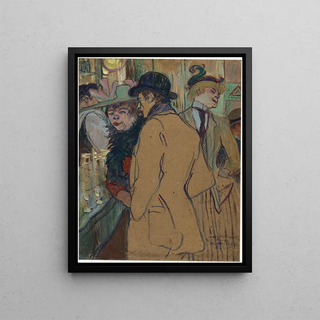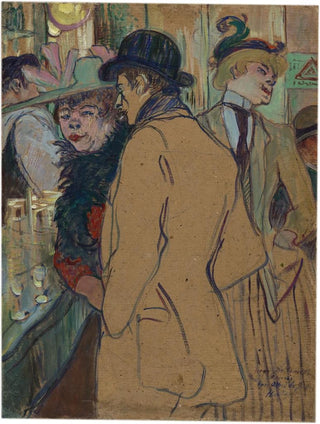Art print | Alfred la Guigne - Henri de Toulouse-Lautrec Source: Reproduction | Alfred la Guigne - Henri de Toulouse-Lautrec


View from behind

Frame (optional)
In the vibrant universe of art, some works transcend time and continue to evoke deep emotions in those who contemplate them. "Alfred la Guigne" by Henri de Toulouse-Lautrec is undoubtedly one of these iconic creations. This piece, which captures the very essence of Parisian nightlife at the end of the 19th century, immerses us in a world full of colors, light, and movement. Toulouse-Lautrec, with his keen eye and artistic sensitivity, manages to immortalize fleeting moments, offering a window into a bygone yet still fascinating era. "Alfred la Guigne" is not merely a depiction of an individual but a testament to the lively atmosphere of Parisian cabarets, where artists, intellectuals, and pleasure-seekers mingled.
Style and uniqueness of the work
The uniqueness of "Alfred la Guigne" lies in how Toulouse-Lautrec manages to synthesize movement and emotion through flowing lines and bold colors. The artist skillfully plays with contrasts, using vivid hues to highlight the personality of his subject while creating a visual dynamic that draws the eye. Alfred's relaxed posture, combined with his pensive expression, evokes a rare psychological depth, making this piece a true portrait of character. Toulouse-Lautrec, master of lithography and painting, succeeds in capturing the essence of his model with such precision that the viewer feels as if they know the man behind the character. This ability to establish an emotional connection with the audience demonstrates the power and modernity of the artist's style.
The artist and his influence
Henri de Toulouse-Lautrec, an emblematic figure of post-impressionism, established himself as a pioneer in representing modern life. His work stands out for its innovative approach, blending Japanese influences and elements of popular culture of his time. Toulouse-Lautrec, due to his own physical condition, developed a particular sensitivity for marginalized individuals and artists of his era, which allowed him to create works imbued with a

Matte finish

View from behind

Frame (optional)
In the vibrant universe of art, some works transcend time and continue to evoke deep emotions in those who contemplate them. "Alfred la Guigne" by Henri de Toulouse-Lautrec is undoubtedly one of these iconic creations. This piece, which captures the very essence of Parisian nightlife at the end of the 19th century, immerses us in a world full of colors, light, and movement. Toulouse-Lautrec, with his keen eye and artistic sensitivity, manages to immortalize fleeting moments, offering a window into a bygone yet still fascinating era. "Alfred la Guigne" is not merely a depiction of an individual but a testament to the lively atmosphere of Parisian cabarets, where artists, intellectuals, and pleasure-seekers mingled.
Style and uniqueness of the work
The uniqueness of "Alfred la Guigne" lies in how Toulouse-Lautrec manages to synthesize movement and emotion through flowing lines and bold colors. The artist skillfully plays with contrasts, using vivid hues to highlight the personality of his subject while creating a visual dynamic that draws the eye. Alfred's relaxed posture, combined with his pensive expression, evokes a rare psychological depth, making this piece a true portrait of character. Toulouse-Lautrec, master of lithography and painting, succeeds in capturing the essence of his model with such precision that the viewer feels as if they know the man behind the character. This ability to establish an emotional connection with the audience demonstrates the power and modernity of the artist's style.
The artist and his influence
Henri de Toulouse-Lautrec, an emblematic figure of post-impressionism, established himself as a pioneer in representing modern life. His work stands out for its innovative approach, blending Japanese influences and elements of popular culture of his time. Toulouse-Lautrec, due to his own physical condition, developed a particular sensitivity for marginalized individuals and artists of his era, which allowed him to create works imbued with a






